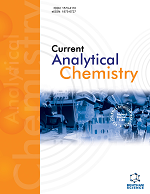- Home
- A-Z Publications
- Current Analytical Chemistry
- Previous Issues
- Volume 20, Issue 3, 2024
Current Analytical Chemistry - Volume 20, Issue 3, 2024
Volume 20, Issue 3, 2024
-
-
Review on Phytoremediation: Toxic Heavy Metal Removal
More LessAmong the environmental contaminants in water, heavy metals and other pollutants are becoming a common occurrence. To solve this issue, the process of phytoremediation was utilized to clear up polluted media. Heavy metal and other pollution contamination of water is becoming more common, which has prompted a conversation that goes beyond heavy metals. These "other pollutants" include a wide range of material Read More
-
-
-
Green Synthesis Derived Novel Fe2O3/ZnO Nanocomposite for Efficient Photocatalytic Degradation of Methyl Orange Dye
More LessAuthors: Nimisha Jadon, Bhupinder Kour, Bilal A. Bhat and Harendra K. SharmaIntroduction: An eco-friendly method was reported for the synthesis of ferric oxide nanoparticles (Fe2O3), zinc oxide nanoparticles (ZnO) and Fe2O3/ZnO nanocomposite using Mangifera indica plant leaf extract as a natural reducing agent. Methods: The synthesized nanomaterials were successfully characterized by X-ray diffraction, UVvisible spectrophotometer, Photoluminescence spectroscopy and Transmission electro Read More
-
-
-
Heavy Metals in Blood Serum of Smokers and Non-smoking Controls
More LessAuthors: Abdulhussein A. Alkufi, Mohanad Hussain Oleiwi and Ali Abid AbojassimBackground: The analysis of heavy metals in the blood serum can serve as a reliable indicator for establishing the association between cigarette smoking and the presence of heavy metals. Methods: In this study, performed in Al-Najaf during 2023, concentrations of three heavy metals - cadmium (Cd), chromium (Cr), and lead (Pb) – were investigated in two groups: cigarette smokers, and non-smokers (the control group) Read More
-
-
-
Construction of a Miniaturized Electrochemical Sensor for Voltammetric Detection of 17β-Estradiol Using a g-C3N4-Decorated Gold Nanoparticles Electrode
More LessAuthors: Yue Ma, Xuqiao Liu, Kai Yan and Jingdong ZhangBackground: 17β-estradiol (E2) is a steroid hormone that has the potential to disrupt the endocrine system, leading to adverse effects on both humans and ecosystems, even when present in low concentrations. The quantitative determination of E2 is of great practical significance. Hypothesis: Electrochemical methods offer several advantages, including low cost, ease of operation, and potential for miniaturization, Read More
-
-
-
Rapid Determination of Diverse Ganoderic Acids in Ganoderma Using UPLC–MS/MS
More LessAuthors: Yan Yang, Yuying Jian and Bin LiuBackground: Ganoderma is known for its pharmaceutical, nutritional, and functional benefits. Its primary bioactive components are ganoderic acids. However, previous quantification methods only analyzed an individual or limited number of ganoderic acids. This study aims to develop a reliable method for simultaneously quantifying the major ganoderic acids to enhance Ganoderma quality control and study its active ing Read More
-
-
-
Quantitative Applications of ATR-FTIR Spectroscopy with Chemometrics for the Estimation of Amikacin in Amikacin Sulphate Injections
More LessAuthors: Chow J. Chen, Bontha V. S. Lokesh and Gabriel Akyirem AkowuahBackground: Amikacin belongs to the class of aminoglycoside antibiotics used in the treatment of gram-negative bacterial infections. It is resistant to the aminoglycosides modifying enzymes, making it a clinically effective drug in multidrug-resistant infections. Methods: In this study, a simple Attenuated Total Reflectance-Fourier Transform Infrared Spectroscopy was used for the quantification of amikacin in amikacin sulphate i Read More
-
-
-
Development of an Indirect ELISA for the Detection of Lactoferrin in Type 2 Diabetes Plasma: A Novel Approach
More LessBackground: In biological systems, lactoferrin (LF) is a crucial protein for protecting the body against diseases and pathogens that can affect both humans and animals. LF is a multifunction protein that binds to different surface receptors to stimulate the innate immune system. In diabetes, lactoferrin has a direct association with inflammation. The effects of inflammation interaction are unknown but reasonably could include Read More
-
Volumes & issues
-
Volume 21 (2025)
-
Volume 20 (2024)
-
Volume 19 (2023)
-
Volume 18 (2022)
-
Volume 17 (2021)
-
Volume 16 (2020)
-
Volume 15 (2019)
-
Volume 14 (2018)
-
Volume 13 (2017)
-
Volume 12 (2016)
-
Volume 11 (2015)
-
Volume 10 (2014)
-
Volume 9 (2013)
-
Volume 8 (2012)
-
Volume 7 (2011)
-
Volume 6 (2010)
-
Volume 5 (2009)
-
Volume 4 (2008)
-
Volume 3 (2007)
-
Volume 2 (2006)
-
Volume 1 (2005)
Most Read This Month
Article
content/journals/cac
Journal
10
5
false
en


